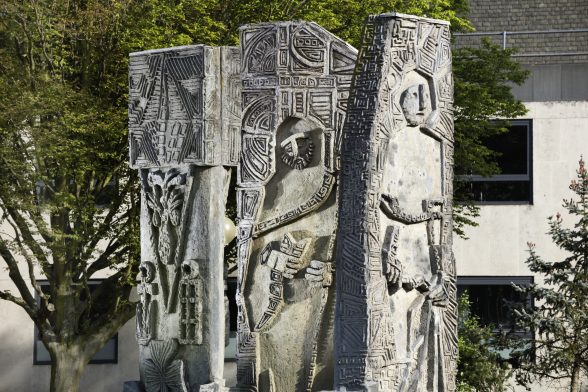This website uses cookies
This website uses cookies to enable it to function properly and to analyse how the website is used. Please click 'Close' to accept and continue using the website.



Image credit: Historic England Archive
The Civic Fountain in Southend-on-Sea, Essex (1967), with panels by artist William Mitchell (1971) has been Grade II listed following support from C20 Society. Mitchell has more artworks listed on the national register (16) than any other artist of the post-war period; his playful murals and sculptures were part of the flourishing of creativity that helped shaped modern Britain – enlivening pedestrian underpasses, roundabouts and civic squares.
In 1967, a new civic complex was created in Southend, which included a car park, council suite and 16-storey Civic Centre, a college, police headquarters, and a courthouse; the complex was officially opened by Queen Elizabeth the Queen Mother. A civic square was designed to form the central heart of the scheme, with a round pool and fountain. The Borough Council was persuaded by its architects to commission William Mitchell to create a sculpture for the fountain and a coat of arms for the nearby council chamber, at a cost of £8,500. The fountain panels were crafted on-site in 1971 using Faircrete – a fibrous concrete which could be moulded like potters’ clay. the Southend fountain is thought to be Mitchell’s only public sculpture using the material.

Image credit: Historic England Archive
‘Modern day standing stones’
The fountain has three sculptural panels, which stand in a circle within a round pool. The nautical and ecclesiastical imagery represents the motto of Southend-on-Sea ‘Per Mare Per Ecclesiam’ (Through the Sea Through the Church) and the city’s coat of arms.
Details include a trefoil (the emblem of the Holy Trinity, representing the parish church of Southchurch), an anchor (the emblem of St Clement, the Patron Saint of Leigh) and a grid iron (the emblem of St Lawrence, the Patron Saint of Eastwood) either side of a vase of lilies in a triangular surround (the emblem of the Virgin, representing the parish of St Mary, Prittlewell).
The south-facing panel has a bearded religious figure on its outward face, possibly representing St Clement, and a hooded monk-like figure on its inward face (likely representing the Cluniac Priory of St Mary, Prittlewell). The west-facing panel has a fisherman in medieval dress on its outward and inward faces (representing Leigh Port), and the fisherman’s net trails along the north side into the water of the round pool.
Catherine Croft, C20 Director, commented:
“The towering tablets of the Southend Civic Fountain are like modern day standing stones; the mariners, monks and decorative nautical motifs depicted are the ancient bonds that tie Southend to the sea. William Mitchell was particularly adept at responding to briefs and designing artwork to suit a particular place, so it’s tremendous to see the fountain being recognised with listing.”

Image credit: Historic England Archive
William Mitchell
William ‘Bill’ Mitchell (1925-2020) was one of the most important sculptors active in England in the post-war period. The Society has long been interested in Mitchell, and several of his works have been saved thanks to our ongoing Murals Campaign, launched in 2009.
Wider appreciation for Mitchell’s work continues to grow and 16 of his artworks are now listed on the national register; however a recent bid to list the inlaid resin mural at Brooklands Park Estate in Greenwich was unsuccessful, while funding is being sought to restore a pair of murals at Foxborough Gardens in Lewisham.
Listed works by William Mitchell:

Become a C20 member today and help save our modern design heritage.